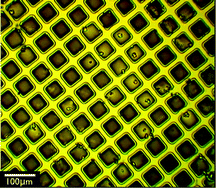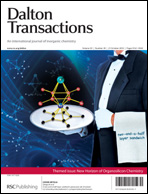This article focuses on a relatively new group of organosilicon polymers known as cyclolinear polycarbosilanes (CLPCS). This group of polymers contains 1,3-disilacyclobutane (DSCB) rings, i.e., cyclo-{RSi(CH2)2SiR}–, bridged by various linking groups, so as to form linear chains with regularly spaced, strained, rings that function as latent sites for cross-linking. This ring-chain, or “beads-on-a-string”, type polymer has the general formula, [–{RSi(CH2)2SiR}–Y–]n, where R and Y can be a variety of different groups, such as: R = –CH3, –C6H5 and –C6H4(CH3); Y = –(CH2)x–, –C6H4–(CH![[double bond, length as m-dash]](https://www.rsc.org/images/entities/char_e001.gif) CH)–C6H4–, and –C6H4–. Depending, in part, on the linking group, these CLPCS have been obtained by using two different synthesis methods, acyclic diene metathesis polymerization (ADMET) and Grignard coupling reactions. The resultant polymers exhibit a wide variation in physical properties, which depend on the nature of the silicon substituents, R, and the bridging group, Y. However, they also share some important characteristics, such as a relatively low glass transition temperature, amenability to the formation of thin films and coatings via spin-coating, and the tendency to undergo cross-linking on heating to 200–300 °C. The synthesis, characterization, and properties of these CLPCS are reviewed and their potential for application in such widely divergent areas as microelectronics processing (as low-k materials), protective, insulating coatings for Cu and other substrates, and photoluminescent films are described.
CH)–C6H4–, and –C6H4–. Depending, in part, on the linking group, these CLPCS have been obtained by using two different synthesis methods, acyclic diene metathesis polymerization (ADMET) and Grignard coupling reactions. The resultant polymers exhibit a wide variation in physical properties, which depend on the nature of the silicon substituents, R, and the bridging group, Y. However, they also share some important characteristics, such as a relatively low glass transition temperature, amenability to the formation of thin films and coatings via spin-coating, and the tendency to undergo cross-linking on heating to 200–300 °C. The synthesis, characterization, and properties of these CLPCS are reviewed and their potential for application in such widely divergent areas as microelectronics processing (as low-k materials), protective, insulating coatings for Cu and other substrates, and photoluminescent films are described.
![[double bond, length as m-dash]](https://www.rsc.org/images/entities/char_e001.gif) CH)–C6H4–, and –C6H4–. Depending, in part, on the linking
CH)–C6H4–, and –C6H4–. Depending, in part, on the linking 

 Please wait while we load your content...
Please wait while we load your content...